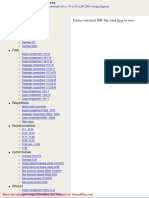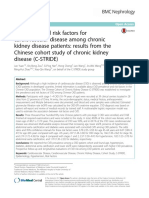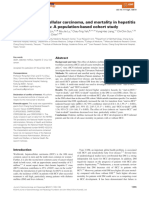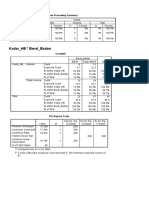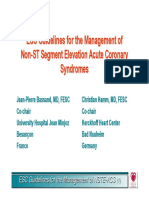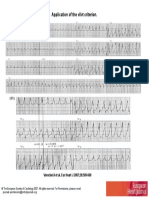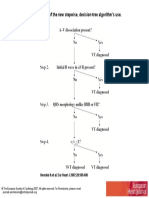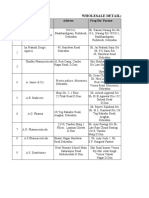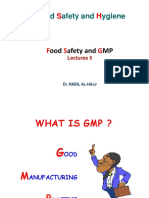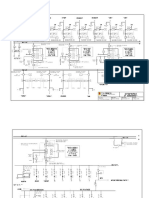Hypocalcemia Is Associated With Disease Severity in Patients With Dengue
Hypocalcemia Is Associated With Disease Severity in Patients With Dengue
Uploaded by
Dwitari Novalia HaraziCopyright:
Available Formats
Hypocalcemia Is Associated With Disease Severity in Patients With Dengue
Hypocalcemia Is Associated With Disease Severity in Patients With Dengue
Uploaded by
Dwitari Novalia HaraziOriginal Title
Copyright
Available Formats
Share this document
Did you find this document useful?
Is this content inappropriate?
Copyright:
Available Formats
Hypocalcemia Is Associated With Disease Severity in Patients With Dengue
Hypocalcemia Is Associated With Disease Severity in Patients With Dengue
Uploaded by
Dwitari Novalia HaraziCopyright:
Available Formats
Brief Original Article
Hypocalcemia is associated with disease severity in patients with dengue
Godwin R Constantine1, Senaka Rajapakse1, Priyanga Ranasinghe2, Balasundaram Parththipan1,
Ananda Wijewickrama3, Priyankara Jayawardana3
1
Department of Clinical Medicine, Faculty of Medicine, University of Colombo, Colombo, Sri Lanka
Department of Pharmacology, Faculty of Medicine, University of Colombo, Colombo, Sri Lanka
3
Ministry of Health Care and Nutrition, Colombo, Sri Lanka
2
Abstract
Introduction: Dengue hemorrhagic fever (DHF) is a major cause of morbidity and mortality in tropical regions. Serum free calcium (Ca 2+) is
known to be important in cardiac and circulatory function. We evaluated association between serum Ca2+ level and severity of dengue.
Methodology:A cross-sectional study was carried out at a tertiary care private hospital in Sri Lanka. A probable case of dengue was
diagnosed and classified according to World Health Organization criteria and confirmed by either IgM antibody, PCR, or NS1 antigen
detection. Socio-demographic details were collected using an interviewer-administered questionnaire.
Results: The sample size was 135. The mean age was 26.1 years, and the majority were males (n = 80, 59.3%). DHF was diagnosed in 71
patients (52.6%). Mean serum Ca2+ level of the study population was 1.05 mmol/L (range 0.771.24). Mean serum Ca2+ was significantly
higher in patients with dengue fever (DF) (1.09 mmol/L) than in those with DHF (1.02 mmol/L) (p < 0.05). A significant difference was
observed between mean serum calcium levels of DHF I and DHF II. Prevalence of hypocalcemia in DHF and DF patients was 86.9% (n =
60) and 29.7% (n = 11), respectively (p < 0.05).
Conclusions: Serum Ca2+ levels significantly correlated with dengue severity. Serum Ca2+ levels were significantly lower and hypocalcemia
was more prevalent in patients with DHF than in patients with DF. Further studies are required to determine whether hypocalcemia can be
utilized as a prognostic indicator and to evaluate effectiveness of calcium therapy in prevention of dengue complications.
Key words: dengue; dengue hemorrhagic fever; serum calcium.
J Infect Dev Ctries 2014; 8(9):1205-1209. doi:10.3855/jidc.4974
(Received 08 March 2014 Accepted 07 July 2014)
Copyright 2014 Constantine et al. This is an open-access article distributed under the Creative Commons Attribution License, which permits unrestricted
use, distribution, and reproduction in any medium, provided the original work is properly cited.
Introduction
Dengue is a disease spread by the Aedes mosquito,
and it is an entity known to mankind since 1780 [1].
After 1960, the incidence of dengue has shown an
exponential increase, with several recent outbreaks
reported mainly from South Asian countries [2].
Nearly 70% of the worlds population at risk of
dengue lives in the Southeast Asian and Western
Pacific regions [2]. Dengue infection and dengue
hemorrhagic fever (DHF) are major causes of
morbidity and mortality in the tropical regions of the
world [3]. It is estimated that 390 million become
infected with dengue per year, of which 96 million
manifest apparently [4]. Due to this high prevalence
and considerable mortality, over the last few years
there has been a heightened interest in disease
prevention and effective strategies for management.
However, at present, the pathogenesis of dengue and
its complications are not completely understood. The
dengue virus is a single-stranded RNA virus of the
genus Flavivirus, comprising four distinct serotypes
(DEN-1 to DEN-4) [5]. Currently, the most accepted
theory is that of an abnormal or amplified
immunological response occurring in a secondary
infection with a different serotype than in the primary
infection [6]. This results in an antibody-dependent
enhancement of immunological reaction, resulting in
endothelial injury, plasma leakage, reduced
intravascular volume, and circulatory collapse [7].
Although no specific pathway has been identified
linking known immunopathogenic events with
definitive effects on microvascular permeability,
thromboregulatory mechanisms, or both, preliminary
data suggest that transient disruption in the function of
the endothelial glycocalyx layer occurs, which
probably enhances leakage [8].
Serum calcium is known to be important in cardiac
and circulatory function. The administration of
intravenous calcium has been a routine practice in
resuscitation protocols for traumatic, hemorrhagic and
Constantine et al. Hypocalcemia and disease severity in dengue
cardiogenic shock, a practice supported by the
presence of hypocalcemia and the observed beneficial
effects of calcium therapy in these conditions [9].
Known cardiovascular manifestations of hypocalcemia
include hypotension, reduced myocardial function,
electrocardiogram (ECG) abnormalities, and heart
failure [10]. Alterations in calcium homeostasis,
therefore, might play a role in the pathogenesis of
shock in patients with dengue infection. Researchers
have postulated that autonomic dysfunction might also
contribute to hypotension in dengue shock syndrome
(DSS) [11]. Calcium entry via neuronal calcium
channels is essential for neurotransmission, hence
calcium plays an important role in the smooth
functioning of the autonomic nervous system [12].
Uddin et al. reported that the mean total calcium levels
were significantly lower in patients with DHF than in
patients with uncomplicated dengue fever (DF) [13].
However, free calcium is a more useful index than
total calcium and provides a better indication of
calcium status [14]. Calcium is transported
predominantly bound to serum albumin; the total
calcium level, therefore, is influenced directly by the
serum albumin concentration. Numerous studies have
clearly demonstrated that the measurement of free
calcium is the test of choice in nearly all diagnostic
and treatment situations [14]. In the present study, we
evaluated the association between serum free calcium
level and disease severity in patients with dengue
infection. To our knowledge, this is the first study
evaluating the association between the severity of
dengue infection and serum free calcium levels.
Methodology
Study population and sampling
A cross-sectional study was performed at a tertiary
care private hospital in Colombo, Sri Lanka, for a
period of six months in 2013. A consecutive sample of
inpatients with confirmed dengue infection was
recruited for the study, after written consent was
obtained. The admission register at the hospital was
used as the sampling frame. Patients with
hypertension, diabetes and cardiac diseases and those
on anti-hypertensive/anti-arrhythmic medications,
calcium supplements, or any other drugs affecting
calcium homeostasis were excluded, as these would
alter the blood pressure, serum calcium levels, and
ECG findings. Ethical approval for the study was
obtained from the Ethics Review Committee, Faculty
of Medicine, University of Colombo, Sri Lanka.
J Infect Dev Ctries 2014; 8(9):1205-1209.
Definitions
A probable case of dengue was diagnosed
according to the World Health Organization (WHO)
criteria [15]. Confirmation of diagnosis was done with
one of the following laboratory tests: IgM antibody
(MAC-ELISA) (PANBIO diagnostics, Brisbane,
Australia), dengue virus RT-PCR (single tube
multiplex RT-PCR was carried out according to the
standard method described previously [16]), or serum
dengue NS1 (non-structural protein 1) antigen
detection (PLATELIA TM Dengue NS1 Ag assay
[BIORAD, Marnes-la-coquette, France]). DHF was
diagnosed and classified in to four stages (DHF I-IV)
according to the WHO criteria as follows: DHF I
positive tourniquet test and/or easy bruising; DHF II
presence of spontaneous bleeding manifestations;
DHF III circulatory failure (rapid, weak pulse and
narrow pulse pressure or hypotension); and DHF IV
profound shock with undetectable pulse and blood
pressure. The prevalence of myocarditis and its
correlation with dengue severity was also analyzed.
Myocarditis was diagnosed either by the presence of
changes in the 12-lead ECG (ST segment, T inversion
or right bundle branch block) or by the twodimensional echocardiogram (2D-echo) findings
(hypo-kinetic segments).
Data collection and analysis
Socio-demographic details were collected using an
interviewer-administered structured questionnaire. The
clinical parameters recorded were presence of
suggestive symptoms (fever, headache, retro-orbital
pain, arthralgia, myalgia, rash, and bleeding
manifestations), evidence of fluid leakage (pleural
effusion and ascitis), pulse rate, and systolic and
diastolic blood pressure. In addition, the following
investigations were performed: white cell count,
platelet count, packed cell volume, serum free calcium
level, ECG, and 2D echo. Blood samples for the
estimation of serum calcium were drawn between days
5 and 10 of the fever. Hypocalcemia was defined as
the presence of a serum free calcium level of < 1.1
mmol/L. All data were double-entered and crosschecked for consistency. Data were analyzed using
SPSS version 14 (SPSS Inc., Chicago, IL, USA)
statistical software package. The significance of the
differences between proportions (%) and means were
tested using the z-test and students t-test or ANOVA,
respectively.
1206
Constantine et al. Hypocalcemia and disease severity in dengue
Results
The sample size was 135, and the mean age was
26.1 years (range 665 years). The majority of the
patients were males (n = 80, 59.3%), and only 4
patients (3%) had a previous history of laboratoryconfirmed dengue infection. The diagnosis was
confirmed by using the dengue NS1 antigen, PCR, or
IgM in 65 (48.1%), 1 (7.4%), and 39 (28.9%) patients,
respectively. DHF was diagnosed in 71 patients
(52.6%), of which 3 (4%) had DHF I, 34 (47.8%) had
DHF II, and 29 (40.8%) had DHF III. There were no
patients with DHF IV in the present cohort, and all
patients recovered completely.
Complete data on serum free calcium was
available only in 107 patients. The mean serum free
calcium level of the study population was 1.05
mmol/L (range 0.771.24). The mean serum free
calcium was significantly higher in patients with DF
(1.09 mmol/L) than in those with DHF (1.02 mmol/L)
(p < 0.05). The mean serum free calcium levels in the
different stages of DHF were: DHF I 1.076 mmol/L;
DHF II 1.022 mmol/L; and DHF III 1.033. A
significant difference was observed between DHF I
and DHF II. Prevalence of hypocalcemia in DHF
patients was 86.9% (n = 60), whereas it was 29.7% (n
= 11) in patients with DF (p < 0.05).
Two-dimensional echo findings were available for
37 patients; no abnormalities were detected in 27
patients (72.9%). Features of myocarditis were present
in 21.6% (n = 8) of patients, all of whom were in the
DHF group. However, only 4 out of the above 8
patients had an ejection fraction of less than 60%.
Dys-synchronic movements in ventricles were
observed in 1 patient. ECGs were available in 51
patients, of which 80.4% (n = 41) had no abnormality.
The commonest abnormality noted was T inversion in
right or/and left leads, which was present in 9 (17.6%)
patients. A right bundle branch block was present in 1
patient. QT changes and ST segment changes were not
observed in the study population. Evidence of
myocarditis (ECG and/or 2D echo) was seen in 16
patients, of which 14 (87.5%) were in the DHF group
and 2 were in the DF group (12.5%) (p < 0.05).
Discussion
Dengue is the most prevalent mosquito-borne viral
infection in the world [17]. Each year, there are 50
million dengue infections and 500,000 individuals
are hospitalized with DHF, mainly in Southeast Asia,
the Pacific, and the Americas [18]. Sri Lanka is a
middle-income developing country in the South Asian
region with a population of over 20 million. It is an
J Infect Dev Ctries 2014; 8(9):1205-1209.
island nation with monsoon periods throughout the
year and is thus a hot spot for dengue infections. The
occurrence of dengue outbreaks in Sri Lanka dates
back to the early 1900s, and since 2000, Sri Lanka has
been struck by periodic outbreaks of dengue with a
steady increase in the case fatality rate [19]. At
present, novel and effective therapeutic and preventive
strategies are of utmost importance.
To our knowledge, this is the first study evaluating
the association between the severity of dengue
infection and serum free calcium levels. Our results
demonstrate that the serum free calcium levels
significantly correlated with the severity of dengue.
The mean serum free calcium was significantly lower
in patients with DHF than in those with DF, and the
prevalence of hypocalcemia was higher in patients
with DHF than in patients with DF. A vast majority of
deaths in dengue infections occur due to severe plasma
leakage that occurs in DHF/DSS [17]. Therefore, the
association between hypocalcemia and the severity of
dengue needs to be further evaluated. The
measurement of serum calcium is currently not a
routine practice in patients with dengue infection.
Further studies are required to determine whether the
presence of hypocalcemia at the onset of the illness
can be utilized as a prognostic indicator to predict
disease severity. A pilot study conducted in Mexico on
a limited number of patients with dengue infection
demonstrated that oral CaCO3 plus vitamin D3
supplementation improved the overall clinical
condition and reduced the duration of illness [20]. In a
similar
study, oral CaCO3 supplementation
significantly increased the number of platelets in
patients with dengue infection when compared with a
control group [21]. However, there are currently no
randomized control trials evaluating the effectiveness
of calcium therapy in the prevention of complications
in dengue infection. Hence, oral or IV calcium therapy
is not routinely included in published guidelines.
Furthermore,
hypocalcemia
has
also
been
demonstrated in certain cases of malaria, severe
meningococcal infections, and other severe acute
illnesses, being associated with a poor prognosis [2224].
Previously, we postulated that transient
sympathetic blunting or failure could be a mechanism
partially responsible for blood pressure changes in
DHF [11]. However, serum calcium level changes
have to be analyzed further to see whether they play a
role in transient sympathetic blunting or failure.
Further human and animal studies are required with
special reference to the place of calcium in
1207
Constantine et al. Hypocalcemia and disease severity in dengue
sympathetic dysfunction. Furthermore, the exact
mechanism for hypocalcemia in severe dengue
infections also requires further study. Possible
mechanisms include leak into the potential third
spaces, disturbance in cellular transport, or changes in
hormones involved in calcium metabolism. There are
several limitations to our study. Our results are from a
cross-sectional analysis; however, prospective cohort
studies are required to determine whether low serum
free calcium is a risk factor for the development of
complications in patients with dengue. In addition,
dengue infection was diagnosed using different tests
(NS1 antigen, PCR, and IgM), with varying
sensitivities, specificities, and limitations [25].
Furthermore, blood samples for estimation of serum
calcium were taken on different days, and from
different patients, which could have influenced the
results. However, it was necessitated by the different
times of presentation of patients and by the
commercial availability.
Conclusions
We demonstrate that the serum free calcium levels
significantly correlated with the severity of DF. The
serum free calcium levels were significantly lower and
hypocalcemia was more prevalent in patients with
DHF than in those with DF. Further studies are
required to determine whether the presence of
hypocalcemia can be utilized as a prognostic indicator
in dengue infection. In addition, randomized control
trials are required to evaluate the effectiveness of
calcium therapy in the prevention of complications in
dengue infection.
Acknowledgements
The authors would like to acknowledge the support
provided by the administrative and medical staff at Asiri
Hospital Lanka (pvt) Ltd.
J Infect Dev Ctries 2014; 8(9):1205-1209.
References
1.
2.
3.
4.
5.
6.
7.
8.
9.
10.
11.
12.
13.
14.
15.
16.
17.
Rush B (1789) An account of the bilious remitting fever, as it
appeared in Philadelphia, in the summer and autumn of the
year 1780. In Medical inquiries and observations, 1st edition.
Philadelphia: Prichard and Hall. 89-100.
Halstead SB (1990) Global epidemiology of dengue
hemorrhagic fever. Southeast Asian J Trop Med Public Health
21: 636-641.
Gubler DJ (1997) The emergence of dengue/dengue
hemorrhagic fever as a global public health problem. In:
Saluzzo JF, Dodet B, editors. Factors in the emergence of
arbovirus diseases. Paris: Elsevier. 83-92.
Bhatt S, Gething PW, Brady OJ, Messina JP, Farlow AW,
Moyes CL, Drake JM, Brownstein JS, Hoen AG, Sankoh O,
Myers MF, George DB, Jaenisch T, Wint GRW, Simmons
CP, Scott TW, Farrar JJ, Hay SI (2013) The global
distribution and burden of dengue. Nature 496: 504-507.
Chambers TJ, Hahn CS, Galler R, Rice CM (1990) Flavivirus
genome organization, expression, and replication. Annu Rev
Microbiol 44: 649-688.
Rothman AL, Green S, Vaughn DW (1997) Dengue
hemorrhagic fever. In: Saluzzo JF, Dodet B, editors. Factors
in the emergence of arbovirus diseases. Paris: Elsevier. 109116.
Srikiatkhachorn A, Krautrachue A, Ratanaprakarn W,
Wongtapradit L, Nithipanya N, Kalayanarooj S, Nisalak A,
Thomas SJ, Gibbons RV, Mammen MP Jr, Libraty DH, Ennis
FA, Rothman AL, Green S (2007) Natural history of plasma
leakage in dengue hemorrhagic fever: a serial
ultrasonographic study. Pediatr Infect Dis J 26: 283-290;
discussion 91-92.
Simmons CP, Farrar JJ, Nguyen VC, Wills B (2012) Dengue.
N Engl J Med 366: 1423-1432.
Cumming AD (1993) The role of calcium in intravenous fluid
therapy. Arch Emerg Med 10: 265-270.
Goldstein DA (1990) Chapter 143: Serum Calcium. In:
Walker HK, Hall WD, Hurst JW, editors. Clinical Methods:
The History, Physical, and Laboratory Examinations, 3rd
edition. Boston: Butterworth.
Vijayabala J, Attapaththu M, Jayawardena P, de Silva SG,
Constantine G (2012) Sympathetic dysfunction as a cause for
hypotension in dengue shock syndrome. Chin Med J 125:
3757-3758.
Ohba T, Takahashi E, Murakami M (2009) Modified
autonomic regulation in mice with a P/Q-type calcium
channel mutation. Biochem Biophys Res Commun 381: 2732.
Uddin NM, Musa AKM, Haque WMM, Sarker RSC, Ahmed
AKMS (2008) Follow up on biochemical parameters in
dengue patients attending birdem hospital. Ibrahim Med Coll
J 2: 25-27.
Sava L, Pillai S, More U, Sontakke A (2005) Serum calcium
measurement: Total versus free (ionized) calcium. Indian J
Clin Biochem 20: 158-161.
World Health Organization (1997) Dengue Haemorrhagic
Fever: Diagnosis, Treatment, Prevention and Control, 2nd
edition. Geneva: WHO.
Harris E, Roberts TG, Smith L, Selle J, Kramer LD, Valle S,
Sandoval E, Balmaseda A (1998) Typing of dengue viruses in
clinical specimens and mosquitoes by single-tube multiplex
reverse transcriptase PCR. J Clin Microbiol 36: 2634-2639.
Guzman MG, Kouri G (2002) Dengue: an update. Lancet
Infect Dis 2: 33-42.
1208
Constantine et al. Hypocalcemia and disease severity in dengue
18. Guzman MG, Halstead SB, Artsob H, Buchy P, Farrar J,
Gubler DJ, Hunsperger E, Kroeger A, Margolis HS, Martnez
E, Nathan MB, Pelegrino JL, Simmons C, Yoksan S, Peeling
RW (2010) Dengue: a continuing global threat. Nat Rev
Microbiol 8: S7-S16.
19. Raheel U, Faheem M, Riaz MN, Kanwal N, Javed F, Zaidi
Nu, Qadri I (2011) Dengue fever in the Indian Subcontinent:
an overview. J Infect Dev Ctries 5: 239-247.
doi:10.3855/jidc.1017.
20. Sanchez-Valdez E, Delgado-Aradillas M, Torres-Martinez
JA, Torres-Benitez JM (2009) Clinical response in patients
with dengue fever to oral calcium plus vitamin D
administration: study of 5 cases. P W Pharmacol Soc 52: 1417.
21. Cabrera-Cortina JI, Sanchez-Valdez E, Cedas-DeLezama D,
Ramirez-Gonzalez MD (2008) Oral calcium administration
attenuates thrombocytopenia in patients with dengue fever.
Report of a pilot study. P W Pharmacol Soc 51: 38-41.
22. Singh PS, Singh N (2012) Tetany with Plasmodium
falciparum infection. J Assoc Physicians India 60: 57-58.
J Infect Dev Ctries 2014; 8(9):1205-1209.
23. Desai TK, Carlson RW, Geheb MA (1988) Prevalence and
clinical implications of hypocalcemia in acutely ill patients in
a medical intensive care setting. Am J Med 84: 209-214.
24. Baines PB, Thomson AP, Fraser WD, Hart CA (2000)
Hypocalcaemia in severe meningococcal infections. Arch Dis
Child 83: 510-513.
25. Kalyani
D,
Bai
MM
(2012)
Evaluation
of
immunochromatographic test in early serological diagnosis of
dengue fever. Indian J Pathol Microbiol 55: 610-611.
Corresponding author
Dr. Godwin R. Constantine (MBBS, MD)
Consultant Cardiologist/Senior Lecturer
Department of Clinical Medicine, Faculty of Medicine
University of Colombo, Sri Lanka
Phone: + 94 777 575683
Email: grogerconstantine@gmail.com
Conflict of interests: No conflict of interests is declared.
1209
You might also like
- Butt Fusion Machine GF 315Document40 pagesButt Fusion Machine GF 315viksof100% (2)
- Volvo v70 Xc70 Xc90 2003 Wiring DiagramDocument20 pagesVolvo v70 Xc70 Xc90 2003 Wiring Diagramjoseph100% (68)
- Metagenics Patient Detox GuideDocument40 pagesMetagenics Patient Detox GuideJessica Bowman100% (2)
- Ship Inspection FormDocument67 pagesShip Inspection Formitavsa100% (4)
- Investment Catalogue in Strategic Sectors 2015 2017 InglésDocument122 pagesInvestment Catalogue in Strategic Sectors 2015 2017 InglésEdwin CandoNo ratings yet
- Rabdomiolise Na DengueDocument7 pagesRabdomiolise Na DengueiomoreiraNo ratings yet
- Predictive Value of Proteinuria in Adult Dengue SeverityDocument6 pagesPredictive Value of Proteinuria in Adult Dengue SeverityWindy SuryaNo ratings yet
- NODocument5 pagesNOReZa FriscaNo ratings yet
- Dengue JournalDocument4 pagesDengue JournalRohitKumarNo ratings yet
- Risk Prediction For Severe Disease and Better Diag - 240327 - 145101Document7 pagesRisk Prediction For Severe Disease and Better Diag - 240327 - 145101thasim.evrNo ratings yet
- Research Article: TNF-Alpha Levels in Tears: A Novel Biomarker To Assess The Degree of Diabetic RetinopathyDocument7 pagesResearch Article: TNF-Alpha Levels in Tears: A Novel Biomarker To Assess The Degree of Diabetic RetinopathytiaraleshaNo ratings yet
- Hyponatremia and Anti-Diuretic Hormone in Legionnaires ' DiseaseDocument9 pagesHyponatremia and Anti-Diuretic Hormone in Legionnaires ' DiseasejuanpbagurNo ratings yet
- Diabetes With Hypertension As Risk Factors For Adult Dengue Hemorrhagic Fever in A Predominantly Dengue Serotype 2 Epidemic: A Case Control StudyDocument12 pagesDiabetes With Hypertension As Risk Factors For Adult Dengue Hemorrhagic Fever in A Predominantly Dengue Serotype 2 Epidemic: A Case Control StudyDwitari Novalia HaraziNo ratings yet
- A Comparison of The Pattern of Liver Involvement in Dengue Hemorrhagic Fever With Classic Dengue FeverDocument5 pagesA Comparison of The Pattern of Liver Involvement in Dengue Hemorrhagic Fever With Classic Dengue FeverMichelle Rayvi J. SumampouwNo ratings yet
- OJEpi20120100001 48070885Document6 pagesOJEpi20120100001 48070885Riodian SaputraNo ratings yet
- Degree of Liver Injury in Dengue Virus Infection: Full Length Research PaperDocument5 pagesDegree of Liver Injury in Dengue Virus Infection: Full Length Research PaperYan Sheng HoNo ratings yet
- Penyakit KawasakiDocument7 pagesPenyakit KawasakiAnonymous kieXEbsGeNo ratings yet
- Research ArticleDocument9 pagesResearch ArticlemahadianismailnstNo ratings yet
- 25rakshitha EtalDocument8 pages25rakshitha EtaleditorijmrhsNo ratings yet
- 10.1097 01.ccm.0000474847.93776.f4Document2 pages10.1097 01.ccm.0000474847.93776.f4nermeen ahmedNo ratings yet
- Sepsis - Eval and MGMTDocument62 pagesSepsis - Eval and MGMTDr Ankit SharmaNo ratings yet
- Assessment of Clinical and Hematological Profile IDocument5 pagesAssessment of Clinical and Hematological Profile IRugvedNo ratings yet
- 2150-Article Text-9122-1-10-20230509Document7 pages2150-Article Text-9122-1-10-20230509munadiatulizzatihamniNo ratings yet
- Delta Neutrophil Index As An Early MDocument9 pagesDelta Neutrophil Index As An Early MFariz NurNo ratings yet
- 1 s2.0 S074152140290621X MainDocument6 pages1 s2.0 S074152140290621X Main1751010307No ratings yet
- Dengue Hemorrhagic Fever: The Sensitivity and Specificity of The World Health Organization Definition For Identification of Severe Cases of Dengue in Thailand, 1994-2005Document10 pagesDengue Hemorrhagic Fever: The Sensitivity and Specificity of The World Health Organization Definition For Identification of Severe Cases of Dengue in Thailand, 1994-2005Dessy AmaranthaNo ratings yet
- Chronic Hepatitis C Increases the Risk of Chronic Kidney Disease (CKD) whileDocument37 pagesChronic Hepatitis C Increases the Risk of Chronic Kidney Disease (CKD) whileNining KurniasihNo ratings yet
- Assessment of Hypokalemia and Clinical Characteristics in Patients With Coronavirus Disease 2019 in Wenzhou ChinaDocument25 pagesAssessment of Hypokalemia and Clinical Characteristics in Patients With Coronavirus Disease 2019 in Wenzhou ChinastedorasNo ratings yet
- JDR2019 7825804Document9 pagesJDR2019 7825804Anonymous Xc7NwZzoNo ratings yet
- Results From PAVE Pilot StudyDocument12 pagesResults From PAVE Pilot StudysnkidNo ratings yet
- 1 RifDocument29 pages1 RifRifdah AmalinaNo ratings yet
- Original Journal About CKDDocument12 pagesOriginal Journal About CKDariesulaemanNo ratings yet
- Journal of SGPTDocument3 pagesJournal of SGPTEric GibsonNo ratings yet
- Global Prevalence of Chronic Kidney Disease - A Systematic Review and Meta-AnalysisDocument18 pagesGlobal Prevalence of Chronic Kidney Disease - A Systematic Review and Meta-AnalysisMellya RizkiNo ratings yet
- Acute Poststreptococcal Glomerulonephritis An UpdateDocument6 pagesAcute Poststreptococcal Glomerulonephritis An UpdateJuan Antonio Herrera LealNo ratings yet
- Evaluation and Management of Suspected Sepsis and Septic Shock in AdultDocument50 pagesEvaluation and Management of Suspected Sepsis and Septic Shock in AdultVanessa LandaNo ratings yet
- Lupus ActiveDocument5 pagesLupus ActivedeliaNo ratings yet
- Evaluation and management of suspected sepsis and septic shock in adults - UpToDateDocument36 pagesEvaluation and management of suspected sepsis and septic shock in adults - UpToDateshanthi.potlaNo ratings yet
- IJCRT23A5059Document9 pagesIJCRT23A5059Agus SunardiNo ratings yet
- A Prospective Observational Study of Dengue Fever With Thrombocytopenia With Reference To TreatmentDocument6 pagesA Prospective Observational Study of Dengue Fever With Thrombocytopenia With Reference To Treatment-Tony Santoso Putra-No ratings yet
- Evaluation and Management of Suspected Sepsis and Septic Shock in Adults - UpToDateDocument37 pagesEvaluation and Management of Suspected Sepsis and Septic Shock in Adults - UpToDatebarcanbiancaNo ratings yet
- Laboratory Features of Systemic Lupus Erythematosus (SLE)Document6 pagesLaboratory Features of Systemic Lupus Erythematosus (SLE)AmrKamalNo ratings yet
- Chen 2013Document6 pagesChen 2013malaNo ratings yet
- Hep Chiv Renal DZDocument9 pagesHep Chiv Renal DZSundar RamanathanNo ratings yet
- Clinical Profile, Etiology, and Management of Hydropneumothorax: An Indian ExperienceDocument5 pagesClinical Profile, Etiology, and Management of Hydropneumothorax: An Indian ExperienceSarah DaniswaraNo ratings yet
- Manuscript 1Document4 pagesManuscript 1maryNo ratings yet
- Background: January 1994 and December 2010Document5 pagesBackground: January 1994 and December 2010بيلييلNo ratings yet
- Association of Admission Serum Calcium Levels and in Hospital Mortality in Patients With Acute ST Elevated Myocardial InfarctionDocument7 pagesAssociation of Admission Serum Calcium Levels and in Hospital Mortality in Patients With Acute ST Elevated Myocardial InfarctionMarcellia AngelinaNo ratings yet
- Kocyigit 2012Document8 pagesKocyigit 2012Rengganis PutriNo ratings yet
- Determining Severe GI BleedDocument8 pagesDetermining Severe GI BleedDanny SilvaNo ratings yet
- The Natural History of Hepatitis C Virus Infection: Host, Viral, and Environmental FactorsDocument0 pagesThe Natural History of Hepatitis C Virus Infection: Host, Viral, and Environmental FactorsAnis Ur RahmanNo ratings yet
- Evaluation and Management of Suspected Sepsis and Septic Shock in AdultsDocument54 pagesEvaluation and Management of Suspected Sepsis and Septic Shock in Adultsdcaguayaa100% (1)
- Admission C-Reactive Protein, WBC Count, Glucose, and Body Temperature in Severe Odontogenic Infections - A Retrospective Study Using Severity ScoresDocument4 pagesAdmission C-Reactive Protein, WBC Count, Glucose, and Body Temperature in Severe Odontogenic Infections - A Retrospective Study Using Severity ScoreslazacaixNo ratings yet
- Global Prevalence of Chronic Kidney Disease - A Systematic Review and Meta-AnalysisDocument19 pagesGlobal Prevalence of Chronic Kidney Disease - A Systematic Review and Meta-AnalysisAngel ViolaNo ratings yet
- Hypercalcemia Leukocytosis SyndromeDocument7 pagesHypercalcemia Leukocytosis SyndromeTun MahadankNo ratings yet
- Use of Blood Product in SepsisDocument6 pagesUse of Blood Product in SepsisAditya IrawanNo ratings yet
- Heparin-Binding Protein: A Diagnostic Biomarker of Urinary Tract Infection in AdultsDocument9 pagesHeparin-Binding Protein: A Diagnostic Biomarker of Urinary Tract Infection in AdultsFitria NurulfathNo ratings yet
- Utility of Atypical Lymphocytes and Large Immature Cells in Prediction of Dengue SeverityDocument6 pagesUtility of Atypical Lymphocytes and Large Immature Cells in Prediction of Dengue SeverityrajNo ratings yet
- Huang Et Al-2017-Journal of Gastroenterology and HepatologyDocument8 pagesHuang Et Al-2017-Journal of Gastroenterology and Hepatologyc6kbfxdfqzNo ratings yet
- حد ادنى نيابات اساسي مايو 2024Document60 pagesحد ادنى نيابات اساسي مايو 2024alganzory112754No ratings yet
- Paediatrica Indonesiana: Natharina Yolanda, Harris AlfanDocument7 pagesPaediatrica Indonesiana: Natharina Yolanda, Harris AlfanFikriakbarNo ratings yet
- bvac130Document8 pagesbvac130parasketchyNo ratings yet
- 302 Cardiovascular Risk: AssessmentDocument1 page302 Cardiovascular Risk: AssessmentLêHữuHoàiNo ratings yet
- Complementary and Alternative Medical Lab Testing Part 8: UrologyFrom EverandComplementary and Alternative Medical Lab Testing Part 8: UrologyRating: 3 out of 5 stars3/5 (1)
- Diagnosis and Management of Autoimmune Hepatitis: A Clinical GuideFrom EverandDiagnosis and Management of Autoimmune Hepatitis: A Clinical GuideMark W. RussoNo ratings yet
- Crosstabs: Valid Missing Total CasesDocument17 pagesCrosstabs: Valid Missing Total CasesDwitari Novalia HaraziNo ratings yet
- Diabetes With Hypertension As Risk Factors For Adult Dengue Hemorrhagic Fever in A Predominantly Dengue Serotype 2 Epidemic: A Case Control StudyDocument12 pagesDiabetes With Hypertension As Risk Factors For Adult Dengue Hemorrhagic Fever in A Predominantly Dengue Serotype 2 Epidemic: A Case Control StudyDwitari Novalia HaraziNo ratings yet
- Guidelines For Cardiac Pacing and Cardiac Resynchronisation TherapyDocument27 pagesGuidelines For Cardiac Pacing and Cardiac Resynchronisation TherapyDwitari Novalia HaraziNo ratings yet
- HSDJXJHDocument134 pagesHSDJXJHDwitari Novalia HaraziNo ratings yet
- Numbers of VT and SVT, True and False Positive Diagnoses Made in Each Step of The New AlgorithmDocument1 pageNumbers of VT and SVT, True and False Positive Diagnoses Made in Each Step of The New AlgorithmDwitari Novalia HaraziNo ratings yet
- HGFDHGDKJHFKJDocument1 pageHGFDHGDKJHFKJDwitari Novalia HaraziNo ratings yet
- A WCT Due To SVT That Was Classified Correctly by The New Algorithm and Misdiagnosed by The Brugada CriteriaDocument1 pageA WCT Due To SVT That Was Classified Correctly by The New Algorithm and Misdiagnosed by The Brugada CriteriaDwitari Novalia HaraziNo ratings yet
- SDJKBFKSZBGVDocument1 pageSDJKBFKSZBGVDwitari Novalia HaraziNo ratings yet
- CkhjvllkvljcyxduytxjhDocument8 pagesCkhjvllkvljcyxduytxjhDwitari Novalia HaraziNo ratings yet
- Brief Summary of The New Stepwise, Decision-Tree Algorithm's UseDocument1 pageBrief Summary of The New Stepwise, Decision-Tree Algorithm's UseDwitari Novalia HaraziNo ratings yet
- Low Diagnostic Yield of Elective Coronary Angiography: Original ArticleDocument10 pagesLow Diagnostic Yield of Elective Coronary Angiography: Original ArticleDwitari Novalia HaraziNo ratings yet
- Cystic FibrosisjgjhvkjDocument9 pagesCystic FibrosisjgjhvkjDwitari Novalia HaraziNo ratings yet
- Gui 288 CPG1303 EDocument16 pagesGui 288 CPG1303 EDwitari Novalia HaraziNo ratings yet
- Main Disease (Filariasis) - 2012Document23 pagesMain Disease (Filariasis) - 2012Dwitari Novalia HaraziNo ratings yet
- Main Disease (Cancer) - Jan 12Document23 pagesMain Disease (Cancer) - Jan 12Dwitari Novalia HaraziNo ratings yet
- Early End of School YearDocument10 pagesEarly End of School YearzmattxsparkzNo ratings yet
- Carboxylic Acid and DerivativesDocument12 pagesCarboxylic Acid and DerivativesJohn Henrick G. Uy50% (2)
- (Cleddie Keith) Praying The Lord's PrayerDocument176 pages(Cleddie Keith) Praying The Lord's PrayerAgnes Vitta Angelia50% (2)
- Case Presentation Doreen Tadala Banda EditedDocument41 pagesCase Presentation Doreen Tadala Banda Editedmaskericon ChivesNo ratings yet
- Abbey Q-Parts Catalogue Section 10Document6 pagesAbbey Q-Parts Catalogue Section 10AbbeyMachineryNo ratings yet
- Introduction To Micro - MD - 2023Document112 pagesIntroduction To Micro - MD - 2023Tall tunaNo ratings yet
- CrwillDocument9 pagesCrwillPawanNo ratings yet
- Wayne P250AF P265F Gas Burner Spec SheetDocument2 pagesWayne P250AF P265F Gas Burner Spec SheetEdwin RodriguezNo ratings yet
- Dehradun Distributor RetailersDocument238 pagesDehradun Distributor RetailersAmit DesaiNo ratings yet
- Buletinul Institutului Politehnic Din Iaşi: Tomul LVIII (LXII) Fasc. 3-4Document170 pagesBuletinul Institutului Politehnic Din Iaşi: Tomul LVIII (LXII) Fasc. 3-4Isabela BalanNo ratings yet
- Turbidity SensorDocument2 pagesTurbidity Sensorveeramaniks408No ratings yet
- Mallett Et Al 2022 PDFDocument14 pagesMallett Et Al 2022 PDFJarrod GottNo ratings yet
- M 3420 SPDocument16 pagesM 3420 SPIxNo ratings yet
- SR Tan TriDocument78 pagesSR Tan TridanielaNo ratings yet
- Tle Reviewer: Nail Onyx Nail Average Growth Is 1/8 Inch Per Month KeratinDocument3 pagesTle Reviewer: Nail Onyx Nail Average Growth Is 1/8 Inch Per Month KeratinFaith GarciaNo ratings yet
- Chonburi PDFDocument81 pagesChonburi PDFJirasak PonchuaNo ratings yet
- Syllabus: Mathematical Analysis I & Linear Algebra (Mathematics I) (6 ECTS)Document5 pagesSyllabus: Mathematical Analysis I & Linear Algebra (Mathematics I) (6 ECTS)Anna ENo ratings yet
- INTERNSHIP Report FINALDocument37 pagesINTERNSHIP Report FINALfahadNo ratings yet
- Food Safety 5, 2023Document17 pagesFood Safety 5, 2023Mohamed MoharrmNo ratings yet
- ASTRO Guide For Core Physics Curriculum For Radiation Oncology ResidentsDocument6 pagesASTRO Guide For Core Physics Curriculum For Radiation Oncology ResidentsAmr MuhammedNo ratings yet
- Bio Optics Lec 1Document28 pagesBio Optics Lec 1Sador YonasNo ratings yet
- 2 - Single Line Diagram Gi KebonagungDocument7 pages2 - Single Line Diagram Gi KebonagungFiKrie X-friendsNo ratings yet
- Tiger Pro 72HC: 530-550 WattDocument2 pagesTiger Pro 72HC: 530-550 WattjeniferNo ratings yet
- BBU Interconnection (SRAN9.0 01)Document61 pagesBBU Interconnection (SRAN9.0 01)Pavel ReshetovNo ratings yet
- CET2014QPBDocument41 pagesCET2014QPBShyam Prasad K SNo ratings yet

